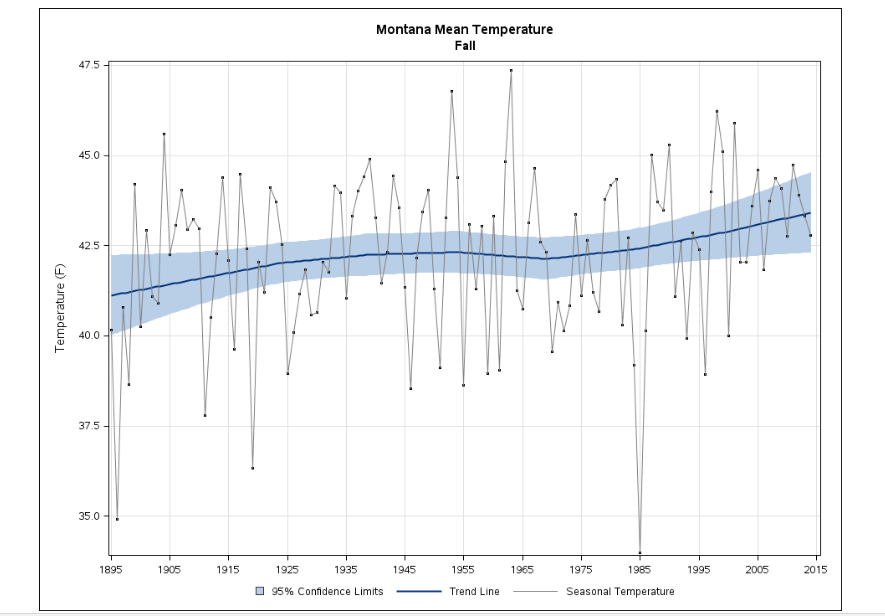Abstract
As a builder of eco-friendly homes, Eco-Built Homes wants to introduce tiny homes, which use solar energy. Analysis of data shows that there are no statistically significant differences between the means of the annual temperature, HDDs, and CDDs recorded in the last five years (2009-2014) and the past sixteen years (1991-2007). Moreover, correlation analysis shows that there is a statistically significant negative relationship between the annual temperature and kWh sales per customer. Therefore, based on the findings, the study recommends the introduction of tiny homes because the trend of kWh sales per customer is increasing with time while the trend of the annual climate change is declining.
Introduction
Eco-Built Homes, which is a construction company located in Billings, builds eco-friendly houses called tiny homes (Eco-Built Homes, 2016). Since tiny homes conserve energy and use less electricity than average homes in Montana, Eco-Built Homes is planning to replace the grid electricity with solar equipment.
Eco-Built Homes assumes that the trend of electricity usage follows that of average homes; however, the management predicts that changes in annual temperature, heating degree days (HDDs) and cooling degree days (CDDs) could have a significant impact on the capacity of the solar equipment to provide adequate energy for tiny homes. Therefore, Eco-Built Homes requires an analysis of the past data of the local consumption of electricity trends to determine if climatic variability has a significant impact on the consumption of electricity and provide an appropriate recommendation.
Methods and Results
The required data was searched and retrieved from the website of the Energy Information Agency (EIA). The appropriated data was sorted by ensuring that they contained Montana residential sales (megawatt-hours) and the number of residential customers from 1991 to 2014 (Energy Information Administration, 2016a). The t-test analysis shows that p-values of annual temperature, HDDs, and CDDs are 0.219, 0.185, and 0.143 respectively.
The t-test analysis reveals that there are no statistically significant differences between the means of annual temperature, HDDs, and CDDs recorded in the last five years (2009-2014) and the past sixteen years (1991-2007). Correlation analysis shows that kWh sales per customer has a negative relationship with the annual temperature (r = -0.453, p = 0.026), a positive relationship with HDDs (r = -0.364, p = 0.081), and a negative relationship with CDDs (r = -0.227, p = 0.286). This analysis means that kWh sales per customer have a statistically significant relationship with the annual temperature while they have statistically insignificant relationships with HDDs and CDDs.
Analysis
From 1991 to 2014, the trends of kWh usage per customer and HDDs have been increasing. In contrast, the trends of the annual temperature and CDDs have been decreasing from 1991 to 2014. Comparatively, the trend of the mean temperature in Montana (Figure 1) increases with time, and thus, it does not match the trend of the findings. However, the departure of the mean temperature (2011-2014) from the mean of the 20th century (Figure2) matches that of the observed trend in the findings. Based on correlation coefficients, the mean annual temperature influences kWh consumption per customer because it has a statistically significant relationship.
Discussion
Extreme weather conditions, which occur in summer and winter, comprise a risk factor because they could increase the consumption of electricity (HDDs or CDDs) beyond the capacity of the solar equipment (Wilbanks & Bilello, 2014). As Montana relies on fossil fuels and wind power as sources of energy (Energy Information Administration (2016b), these sources act as a risk for they may hinder the adoption of solar equipment.
Thus, extreme weather conditions and the reliance on other sources of energy limit the introduction of solar power equipment in tiny homes. The best recommendation Eco-Built Homes should exploit the potential market of tiny homes because the trend of kWh consumption of electricity has been increasing with time in response to the declining mean annual temperature, which is statistically significant.


References
Eco-Built Homes. (2016). Developing the Future Living Environment. Web.
Energy Information Administration. (2016a). Electricity data: Detailed state data. Web.
Energy Information Administration. (2016b). Montana: Profile analysis. Web.
National Oceanic and Atmospheric Administration (2016b). State annual and seasonal time series: Decadal average temperature maps. Web.
Wilbanks, J., & Bilello, D. (2014). Climate change and energy supply and use. Washington, WA: Island Press.